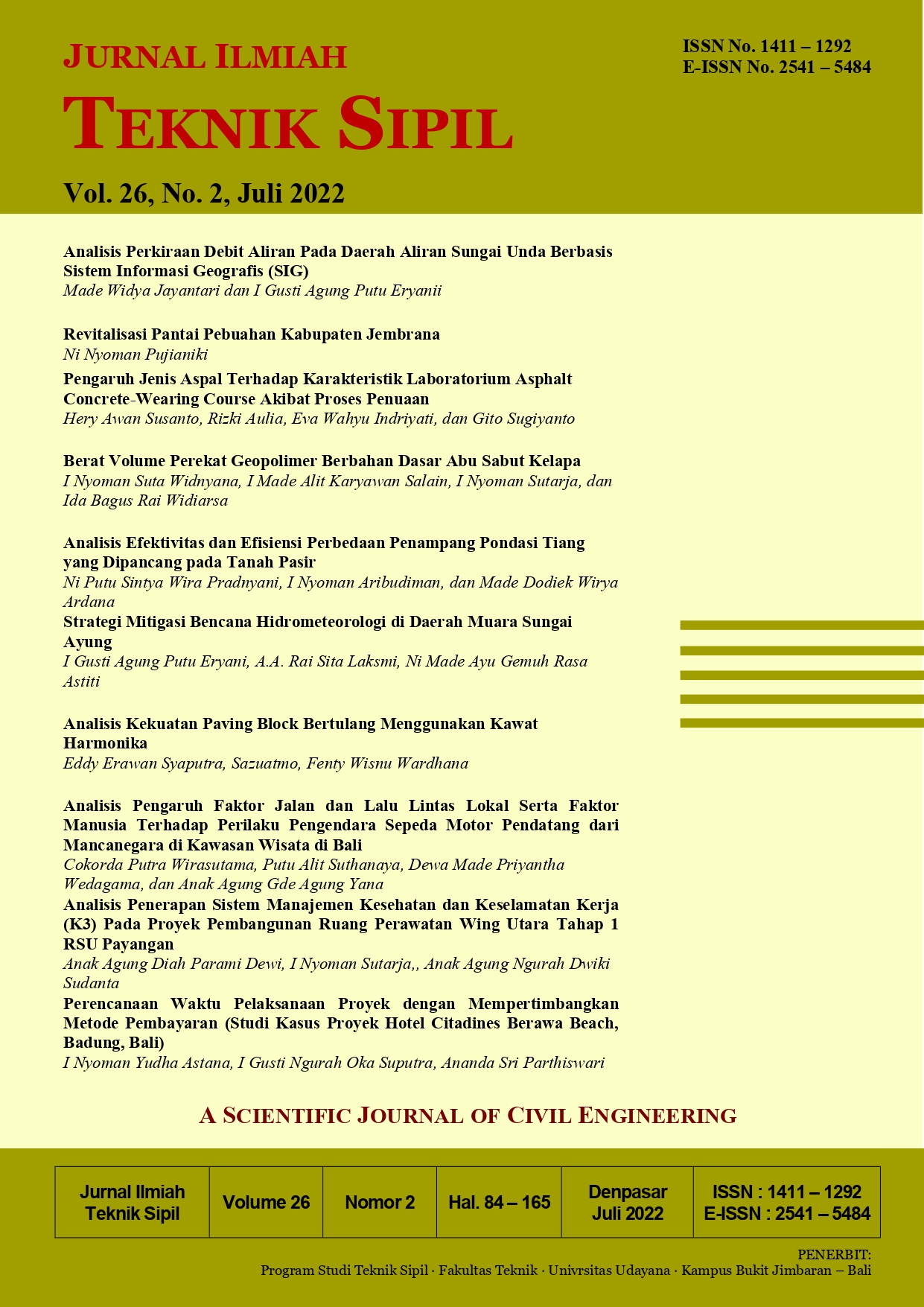STRATEGI MITIGASI BENCANA HIDROMETEOROLOGI DI DAERAH MUARA SUNGAI AYUNG
Abstract
Bencana hidrometeorologi adalah suatu peristiwa atau rangkaian peristiwa banjir, longsor, kerusakan ekosistem, degradasi lahan, angin puting beliung, dan kekeringan, yang dapat mengancam kehidupan masyarakat. Perubahan iklim yang terjadi saat ini, juga disinyalir menyebabkan meningkatnya bencana hidrometeorologi. Karakteristik muara yang khas yaitu pertemuan antara aliran sungai dan laut, meningkatkan potensi bencana hidrometeorologi. Oleh sebab itu perlu dilakukan mitigasi bencana hidrometeorologi di Muara Sungai Ayung untuk mengurangi dampak-dampak negatif yang dapat terjadi akibat kondisi hidrometeorologinya. Penelitian ini merupakan penelitian kuantitatif deskriptif. Data Meteorologi yang didapat dari data satelit digunakan untuk melihat karakteristik meteorologi di Muara Sungai Ayung. Berdasarkan hasil analisis diketahui bahwa beberapa kondisi hidrometeorologi daerah muara Sungai Ayung menunjukan potensi bencana hidrometeorologi, seperti peningkatan kecepatan angin maksimum yang mencapai 1,5 kali kecepatan rata-ratanya, terjadi peningkatan temperatur yang berkisar 6-8°C dari temperatur rata-ratanya dan kondisi curah hujan harian ada yang mencapai lebih dari 100 mm/hari. Upaya mitigasi yang dapat dilakukan di Muara Sungai Ayung dapat dilakukan dengan banyak tindakan seperti structural, non structural dan solusi berbasis alam potensial (pendekatan infrastruktur biru, hijau dan hybrid).
Downloads
References
Balai Besar Meteorologi Klimatologi dan Geofisika Wilayah III. 2022. Informasi Iklim Ekstrim Wilayah Bali. [cited Available from: URL: http://balai3.denpasar.bmkg.go.id/info-iklim-ektrim
Barus, B.S., Pratama, M.A.P., Putri, W.A.E. 2020. Perubahan Garis Pantai Di Perairan Muara Banyuasin Kaitannya Dengan Sedimentasi. Jurnal Ilmu Dan Teknologi Kelautan Tropis, 12(1): 107–118.
Choi, H., Moon, T., Jung, D.H., Son, J.E. 2019. Prediction of Air Temperature and Relative Humidity in Greenhouse via a Multilayer Perceptron Using Environmental Factors. Protected Horticulture and Plant Factory, 28(2): 95–103.
Efendi, Z. 2019. Pengaruh Kelembaban Relatif (Relative Humidity) Terhadap Laju Perpindahan Massa Pada Proses Pengeringan.
Eryani, I. G. A. P., Jayantari, M.W. 2021. Mapping of Flood Vulnerability and Mitigation Strategy of Unda River Basin Using Geographical Information System. The International Journal of Engineering and Science (IJES), 10(10): 53–61.
Eryani, I Gusti Agung Putu, Yujana, C.A. 2018. Pengelolaan Dan Pengembangan Sumber Daya Air Di Muara Sungai Ayung Provinsi Bali Berbasis Kearifan Lokal. Konferensi Nasional Teknik Sipil 12, (September): 83–90.
Huang, S., Yin, X., Zhao, X. 2018. The Effects of Saltwater Intrusion on Suspended Sediment Movement in Estuary. IOP Conference Series: Earth and Environmental Science, 121(5): 0–6.
Mathew, R., Winterwerp, J.C. 2020. Sediment Dynamics and Transport Regimes in a Narrow Microtidal Estuary. Ocean Dynamics, 70(4): 435–462.
McCarl, B.A., Yu, C.H., Attavanich, W. 2021. Climate Change Impacts and Strategies for Mitigation and Adaptation in Agriculture. Atmosphere, 12(5): 1–20.
Meucci, A., Young, I.R., Breivik, Ø. 2018. Wind and Wave Extremes from Atmosphere and Wave Model Ensembles. Journal of Climate, 31(21): 8819–8842.
Pandit, R.K., Kolios, A., Infield, D. 2020. Data-Driven Weather Forecasting Models Performance Comparison for Improving Offshore Wind Turbine Availability and Maintenance. IET Renewable Power Generation, 14(13): 2386–2394.
Perkins, S. 2011. Rising Temperatures Bringing Bigger Floods.
Qin, P., Xu, H., Liu, M., Du, L., Xiao, C., Liu, L., Tarroja, B. 2020. Climate Change Impacts on Three Gorges Reservoir Impoundment and Hydropower Generation. Journal of Hydrology, 580(July 2019): 123922.
Rejekinigrum, P. 2014. Dampak Perubahan Iklim Terhadap Sumberdaya Air: Identifikasi, Simulasi, Dan Rencana Aksi. Jurnal Sumberdaya Lahan, 8(1).
Schilling, J., Hertig, E., Tramblay, Y., Scheffran, J. 2020. Climate Change Vulnerability, Water Resources and Social Implications in North Africa. Regional Environmental Change, 20(1).
Siboro, I.F. 2021. “Identifikasi Pengetahuan Masyarakat Terkait Penyebab Dan Mitigasi Bencana Hidrometeorologi Di Kabupaten Labuhanbatu Utara Provinsi Sumatera Utara.” Universitas Sumatera Utara.
World Bank. 2013. Climate change impacts on water resources and adaptation in the rural Water Supply and Sanitation sector in Nicaragua. 1–39.
Zhu, M., Liu, W., Wargocki, P. 2020. Changes in EEG Signals during the Cognitive Activity at Varying Air Temperature and Relative Humidity. Journal of Exposure Science and Environmental Epidemiology, 30(2): 285–298.





